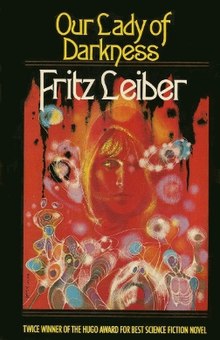Our Lady of Darkness(1977) is anurban fantasynovel by American authorFritz Leiber.The novel is distinguished for three elements: the heavily autobiographical elements in the story, the use ofJungian psychologythat informs the narrative, and its detailed description of "megapolisomancy", a fictional occult science. It was originally published in shorter form asThe Pale Brown Thing(Magazine of Fantasy and Science Fiction,January/February 1977).

Plot
editThe story centers on Franz Westen, a recovering alcoholic and writer of weird tales, who lives in San Francisco.
The plot unfolds as Westen discovers an old journal belonging toClark Ashton Smith,a real-life writer of fantasy, horror, and science fiction. In this journal, Smith discusses "paramentals", entities that feed off of human emotions and are drawn to urban environments. As Westen delves deeper, he learns about "megapolisomancy", a fictional occult science focusing on harnessing the supernatural forces present in large cities.
Westen begins to experience bizarre and terrifying occurrences. He sees mysterious figures on nearby rooftops and encounters eerie phenomena, suggesting the presence of supernatural forces in the city. The novel's climax involves Westen's confrontation with these forces, symbolized by the entity "Our Lady of Darkness" – a powerful, ancient being connected to the history and fabric of San Francisco itself.
Autobiographical elements
editLike the protagonist Franz Westen, Leiber was recovering from his wife's death a number of years previously and descending into alcoholism. Like the author, Westen is an amateur astronomer who is looking for ways to re-engage with the life around him, and he lives at the address (811 Geary St) where Leiber lived at the time. The novel is set in actual San Francisco locations, includingCorona Heightsand theSutro Towerbehind it. As late as 2012, fantasy fans could take a walking tour of the city that included all the novel's main locations. Several of the other characters are thinly disguised versions of people active in Bay Area fandom in the mid-1970s.
The novel mentions the authorsJack London,Ambrose BierceandClark Ashton Smith,who all lived part of their lives in San Francisco. The title is taken fromThomas De Quincey'sSuspiria de Profundis,and references are also made toM. R. James's ghost stories, and to the work of fantasy/horror writers such asH.P. Lovecraft.These allusions add an element ofmetafictionto the story, making it in part an examination and description of horror and the imagination.
Jungian elements
editAdding to the metafictional elements of the story are Leiber's frequent references toJung's descriptions of theAnima(female self) and theShadow(hidden self). These are elements that existed in Leiber's work nearly since the start of his career in the late 1930s, according to Bruce Byfield'sWitches of the Mind: A Critical Study of Fritz Leiber.The main difference inOur Lady of Darknessis that, unlike much of his earlier works, the references to these figures are explicit, rather than implied, and at times supported by direct quotations.
The Pale Brown Thing
editOur Lady of Darknesswas originally serialised, in shorter form and with the titleThe Pale Brown Thing,over two issues of theMagazine of Fantasy and Science Fiction(January/February 1977). The story was featured on the cover of the January issue with a painting byRon Walotsky.[1]
Fritz Leiber maintained that the two texts "should be regarded as the same story told at different times".[2]
The Pale Brown Thingwas reissued bySwan River Pressin 2016 as a limited edition hardback. The cover byJason Zerrillois an homage to Walotsky's original artwork forF&SF.[3]The volume includes an introduction by Leiber's friend, the San Francisco poetDonald Sidney-Fryer,who was the basis for the character of Jaime Donaldus Byers.[4]It also includes a reprint of an essay by John Howard, "Story-telling Wonder-questing, Mortal Me: The Transformation ofThe Pale Brown ThingintoOur Lady of Darkness",which examines the differences betweenThe Pale Brown Thingand its later, lengthier incarnation.[5]
Reception
editOur Lady of Darknesswon the 1978World Fantasy Award for Best Novel.[6]
Richard A. LupoffpraisedOur Lady of Darknessas "one of the scariest, most original, and most damnablyconvincingfantasy notions I've ever come across ".[7]
See also
edit- False document
- Kult,a role playing game with some similar ideas on the quirks of big cities
- Geomancy
References
edit- ^"The FictionMags Index".Retrieved27 June2020.
- ^"The Pale Brown Thing and a Dose of De Quincy".14 July 2016.Retrieved27 June2020.
- ^"Fritz Leiber's 'The Pale Brown Thing'".19 June 2016.Retrieved27 June2020.
- ^"The Power of Friendship: An Interview with Donald Sidney-Fryer".Retrieved27 June2020.
- ^"Story-telling Wonder-questing, Mortal Me",Touchstones: Essays on the Fantastic,Alchemy Press, 2014.
- ^"World Fantasy Award Winners".Retrieved27 June2020.
- ^"Lupoff's Book Week",Algol28, 1977, p.53.
External links
edit- "Fritz Leiber Reading an Extract fromOur Lady of Darkness"
- "Fritz Leiber Discussing the Composition and Background ofThe Pale Brown Thing"
- "The Power of Friendship: An Interview with Donald Sidney-Fryer"
- Perry Lake,"Stalking Our Lady of Darkness"
- Ray Faraday Nelson,review
- Rosemary Pardoe,"Our Lady of Darkness: A Jamesian Classic"